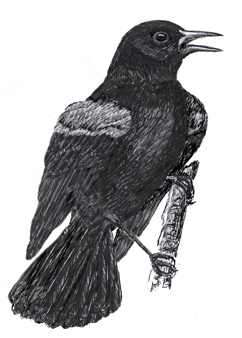
Dear Bird Folks:
Every March we look forward to the return of the red-winged blackbirds. Do you think that this nasty winter will delay their return?
Joe, Barnstable
Joe Dude, relax:
The red-wings are back, at least some of them are. A week of zillion degrees below zero weather isn’t going to keep those guys from reaching their breeding grounds. These aren’t little sissy birds, we are talking about red-winged blackbirds here.
You would think that all this snow and ice would make the birds forget about spring, hunker down and wait for things to warm up a bit. But try to remember that red-wings don’t watch the Weather Channel (the constant rate hikes have forced them to cancel their cable subcription). The birds don’t know that we are in for a lengthy stretch of below normal temperatures. This is the time of year when red-wings return from the south and they aren’t about to let any meteorologist talk them out of it.
Bird migration is amazingly complicated and not completely understood. Weather is a factor in migration, but probably not the most important factor. If sunny warm weather was the key to bird migration, then the birds in England would never move, except in a cab. A more important trigger for birds is the length of day. Longer minutes of sunlight stimulate the bird’s hormones. You, Joe, of all people, should know that hormones rule the world. It is no different with birds. Longer days cause wintering birds to become restless and anxious to head north. It may seem foolish to fly back to this kind of wether, but for many birds the window of opportunity to breed is small.
Since they don’t winter very far away, male red-winged blackbirds are one of the first spring migrants to arrive back on the Cape. Arriving early is important to them because they don’t pair up on the wintering grounds. Like people, some birds are paired up as soon as they leave high school. Then there are those who have a new mate every season. Red-wings are in that second group. The steamy events of last season are just a memory now. If the males want to be a player again, they need to arrive early and set up in primo territory.
And if all goes well, some males will mate with more than one female. Although tests confirm that many male red-wings have more than one mate, they don’t have nearly as many as they brag about having.
As soon as the mates arrive they get down to work singing and advertising a territory. The females on the other hand arrive weeks after the males. They want all the snow shoveled out before they show up. If you take a walk near a marsh, even in this rotten weather, you’ll hear the males singing “konk-la-ree.” Which, of course, is red-wing for “check out my swamp, baby.” In addition to the calls, the red-wing’s wings become a major attraction this time of year. The brilliant red patches on the wings, that are mostly hidden the rest of the year, suddenly become flashed about, making the birds look like a group of male fan dancers living in the marsh.
In addition to the red-wings returning, you may have already noticed that our resident birds have started singing. Cardinal pairs are calling back and forth and chickadees are giving off their welcome springtime two-note whistle. Although they seem to sing louder on nicer days, it’s the longer days that are pushing them into spring mode, no matter how nasty the weather is.
As March moves along, whether the weather is good or bad, more and more red-wings will be arriving on our marshes. And soon after that will come the ticks, the biting insects and then the traffic. So enjoy this rotten weather while it lasts.